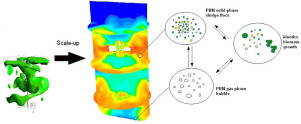当前位置:
X-MOL 学术
›
Int. J. Multiphase Flow
›
论文详情
Our official English website, www.x-mol.net, welcomes your feedback! (Note: you will need to create a separate account there.)
Co-simulation of CFD-multiphase population balance coupled model aeration of sludge flocs in stirrer tank bioreactor
International Journal of Multiphase Flow ( IF 3.8 ) Pub Date : 2020-02-01 , DOI: 10.1016/j.ijmultiphaseflow.2019.103162 Artur Wodołażski
International Journal of Multiphase Flow ( IF 3.8 ) Pub Date : 2020-02-01 , DOI: 10.1016/j.ijmultiphaseflow.2019.103162 Artur Wodołażski

|
Abstract Aerated stirrer tank bioreactors are commonly used to convert organics and remove nutrients through microbial floc environments. Computational Fluid Dynamic CFD based on multiphase approach coupled with gas (air) and solid (sludge flocs) population balance models (pbm) are using in co-simulation to modelling dynamics complex multiphysics phenomena in different time scales. Co-simulation coupled CFD-PBM-kinetic models to captured the biomass growth kinetics and the influence of the reactor hydrodynamics on the overall process. Floc size distribution is crucial as it determines distinct grades of final floc structures, which are to be used as commercial aerobic wastewater treatment respectively. The coupled population balance equation was solved using an inhomogeneous discrete method of the continuous partial differential equation for sludge flocs and standard methods of moments for gas phase, which were then solved simultaneously and influence on biomass kinetics growth. Additionally, the influence of the agitator's speed and air flow rate on dynamic biomass growth have been investigated in full transient CFD analysis. The kinetics of biomass growth rate, as a function of oxygen saturation and air/flocs population balance was employed in the model through User Defined Function (UDF). The integrated modelling multiphysics in a multiphase system methodology by co-simulation represents a valuable tool to examine the impact of individual parameters of the biomass growth in the bioreactor.
中文翻译:

搅拌槽生物反应器污泥絮体CFD-多相种群平衡耦合模型曝气联合仿真
摘要 曝气搅拌槽生物反应器通常用于通过微生物絮团环境转化有机物和去除营养物质。基于多相方法的计算流体动力学 CFD 结合气体(空气)和固体(污泥絮凝物)种群平衡模型 (pbm) 正在联合仿真中用于模拟不同时间尺度的复杂多物理场现象。联合仿真结合 CFD-PBM 动力学模型来捕捉生物质生长动力学和反应器流体动力学对整个过程的影响。絮体大小分布至关重要,因为它决定了最终絮体结构的不同等级,这些结构分别用于商业好氧废水处理。耦合种群平衡方程使用污泥絮体连续偏微分方程的非齐次离散方法和气相标准矩法求解,然后同时求解并影响生物质动力学生长。此外,搅拌器的速度和空气流速对动态生物质生长的影响已经在全瞬态 CFD 分析中进行了研究。通过用户定义函数 (UDF) 在模型中采用生物量增长率的动力学,作为氧饱和度和空气/絮状物种群平衡的函数。通过联合仿真在多相系统方法中对多物理场进行集成建模代表了一种有价值的工具,可以检查生物反应器中生物质生长的各个参数的影响。
更新日期:2020-02-01
中文翻译:

搅拌槽生物反应器污泥絮体CFD-多相种群平衡耦合模型曝气联合仿真
摘要 曝气搅拌槽生物反应器通常用于通过微生物絮团环境转化有机物和去除营养物质。基于多相方法的计算流体动力学 CFD 结合气体(空气)和固体(污泥絮凝物)种群平衡模型 (pbm) 正在联合仿真中用于模拟不同时间尺度的复杂多物理场现象。联合仿真结合 CFD-PBM 动力学模型来捕捉生物质生长动力学和反应器流体动力学对整个过程的影响。絮体大小分布至关重要,因为它决定了最终絮体结构的不同等级,这些结构分别用于商业好氧废水处理。耦合种群平衡方程使用污泥絮体连续偏微分方程的非齐次离散方法和气相标准矩法求解,然后同时求解并影响生物质动力学生长。此外,搅拌器的速度和空气流速对动态生物质生长的影响已经在全瞬态 CFD 分析中进行了研究。通过用户定义函数 (UDF) 在模型中采用生物量增长率的动力学,作为氧饱和度和空气/絮状物种群平衡的函数。通过联合仿真在多相系统方法中对多物理场进行集成建模代表了一种有价值的工具,可以检查生物反应器中生物质生长的各个参数的影响。



























 京公网安备 11010802027423号
京公网安备 11010802027423号